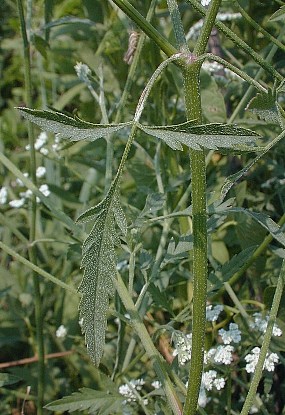Description: This plant is a winter or spring annual that becomes about 2' tall, branching occasionally. The stems are slender and round. They are more or less covered with fine hairs that are white and short. The alternate leaves are pinnately or bipinnately compound, and have petioles that are long and slender. These leaves have a triangular shape in outline and a fern-like appearance, spanning up to 6" long and 4" across (excluding the petioles) and becoming smaller in size as they ascend the stems. Some of the upper leaves near the inflorescence are lanceolate or narrowly ovate. The leaflets of the compound leaves are trifoliate. They have rather slender with wedge-shaped bottoms, while their margins are cleft or coarsely toothed. The upper surface of each leaflet is sparsely covered with short white hairs.

The upper stems
terminate in compound umbels of small white flowers on long naked
stalks. Each compound umbel is about 2–3" across, consisting of about 8
umbellets. The base of each compound umbel is usually without bracts,
although sometimes there is a single linear bract. An umbellet has
about 8 flowers and a similar number of small linear bracts at its
base. Each flower is about 1/8" (3 mm.) across, with 5 white petals and
5
stamens. The blooming period usually occurs from early to mid-summer
and lasts about a month. This plant has a tendency to sprawl because of
the weight of the umbels of flowers on their long slender stalks. Upon
maturity, each flower is replaced by a single seed. This seed is oblong
and has a bur-like covering of bristles. It is initially rosy to
whitish green in appearance, but later turns brown. The bristles are
straight to slightly curved; they do not have hooked tips. The root
system consists of a taproot. This plant spreads by a reseeding itelf,
and it often forms colonies.
Cultivation:
The preference is full sun, mesic to dry conditions, and a rather heavy
soil containing gravel or clay. Because this plant often grows in soil
containing limestone gravel, it appears to tolerate alkaline
conditions. It matures quickly during the growing season, produces
flowers and seeds, and then dies, although the stems remain more or
less erect for some time.

Range & Habitat:
The non-native Common Hedge Parsley occurs primarily in southern,
central, and NE
Illinois, where it is occasional to locally common. In NW Illinois, it
is rare or absent (see Distribution
Map). This species is adventive from Eurasia, and it appears
to be
spreading throughout the state. Habitats include thickets, woodland
borders, weedy meadows, areas along railroads and roadsides, gravelly
areas along streams, and waste areas. Disturbed habitats are preferred,
including degraded prairies and woodlands that have been recently
logged.
Faunal Associations:
Like other members of the Carrot family, the small white flowers
attract various insects, including small bees, flies, wasps, and
beetles. The caterpillars of the butterfly Papilio polyxenes
asterius (Black Swallowtail) feed on the foliage. The
bur-like covering of the seeds clings readily to the fur of mammals,
the feathers of birds, and the clothing of humans. Thus, animals help
to distribute the seeds far and wide. The foliage is not known to be
toxic, and it may be eaten occasionally by mammalian herbivores.
Photographic Location:
The edge of a degraded prairie along a railroad where there is an
abundance of limestone gravel in Savoy, Illinois.
Comments:
Common Hedge Parsley grows in similar habitats and has a similar
appearance to Daucus carota (Wild Carrot). However,
it is a shorter plant that blooms earlier in the year. The leaves and
stems of Common Hedge Parsley are more or less covered with fine white
hairs, while the foliage of Wild Carrot is nearly hairless. Even more
significantly, the floral bracts of Common Hedge Parsley are either
absent or inconspicuous, while the floral bracts of Wild Carrot are
quite long, abundant, and conspicuous. The most distinctive
characteristic of Torilis spp. is the bur-like
seeds, which are often rosy-green in appearance and have a dense
covering of fine bristles. It can be a major inconvenience to walk
through a colony of these plants, as the abundant bur-like seeds cling
tenaciously to clothing and are difficult to remove. For a long time,
Common Hedge Parsley was incorrectly identified as Torilis
japonica (Japanese Hedge Parsley). However, this latter
species has about 8 linear bracts at the base of each compound umbel,
and the bristles of its seeds have hooked tips. While Japanese Hedge
Parsley occurs in Illinois, it far less common than Common Hedge
Parsley. As a result of this misidentification, the distribution
records within the state include observations of both species.